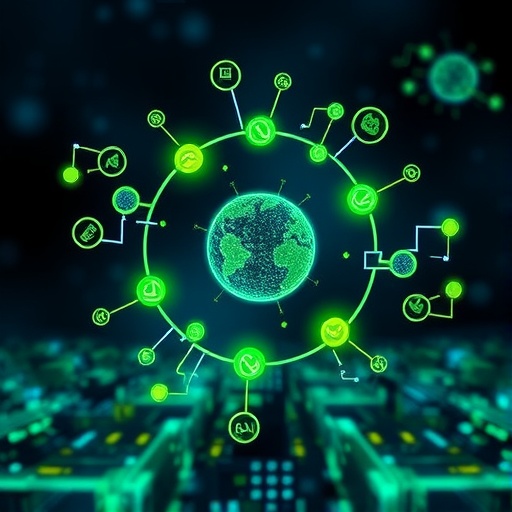In the rapidly evolving landscape of artificial intelligence (AI), the quest for sustainable practices has become paramount. The latest research by R. Ranpara focuses on constructing energy-efficient AI architectures that serve the dual purpose of enhancing processing capabilities while adhering to the principles of circular economies. This innovative approach centers on a multi-layered sustainable resource optimization framework that could potentially redefine how we view the intersection of technology and environmental stewardship. The implications of such frameworks extend into myriad industries, suggesting a paradigm shift towards more responsible AI usage.
Energy consumption is a critical concern in the development of AI algorithms, where traditional models often require extensive computational resources. This demand not only leads to higher operational costs but also contributes to an increased carbon footprint. Ranpara’s research highlights the vital need for optimizing AI systems to operate effectively within the constraints of energy efficiency. By leveraging green AI architectures, the work advocates for solutions that mitigate environmental impact while maintaining high performance levels, thus ensuring the sustainability of technological advancements.
At the heart of Ranpara’s framework is the principle of circular economy, which emphasizes the importance of rethinking product lifecycles. In a conventional linear economy, products are created, used, and then disposed of, leading to wastefulness and resource depletion. Conversely, a circular economy aims to keep products, materials, and resources in use for as long as possible, thereby minimizing waste. Ranpara’s approach uses this principle as a foundation to build AI systems that are not just efficient but also considerate of resource longevity, allowing for a more sustainable future in AI development.
Central to the multi-layered sustainable resource optimization framework is the integration of various strategies that contribute to energy efficiency. These include advanced algorithms that prioritize resource allocation and performance metrics that measure energy consumption alongside computational outcomes. By analyzing and optimizing the energy use of AI systems, Ranpara posits that it is possible to achieve a balance between technological progress and environmental responsibility, ultimately paving the way for greener AI innovations.
One striking feature of this research is the embrace of renewable energy sources within AI architectures. As global industries move toward carbon-neutral goals, the inclusion of clean energy in AI process execution can significantly lower greenhouse gas emissions. Ranpara’s work suggests that AI systems designed to harness solar, wind, and other renewable resources not only reduce reliance on fossil fuels but also bring about cost efficiencies. The potential for machine learning models that optimize renewable resource utilization in real-time adds another layer of sophistication to AI energy management.
The study also addresses the current challenges faced in implementing green AI architectures, particularly the varied degrees of market readiness for sustainable technologies across different sectors. While tech giants and startups in developed regions may have access to resources for developing these architectures, emerging markets might face barriers such as financial constraints and lack of technological infrastructure. Ranpara argues for a collaborative approach, where stakeholders across various industries can share knowledge and resources to accelerate the adoption of sustainable practices in AI.
An equally important aspect of the research is the emphasis on a multi-disciplinary approach. The intersection of AI, ecology, and engineering is crucial; thus, collaboration across fields is necessary to foster innovative ideas that lead to effective sustainable solutions. In engaging experts from diverse domains, Ranpara believes that it’s possible to engineer AI systems that are not just resource-efficient but also socially and environmentally responsible. This holistic perspective is vital for addressing the complex challenges posed by climate change.
Furthermore, the potential economic benefits of transitioning to energy-efficient AI architectures are noteworthy. As sustainability becomes a critical factor in investment and consumer decisions, companies embracing green AI practices are likely to gain a competitive edge. Consumers increasingly prefer brands that demonstrate environmental responsibility, and businesses can capitalize on this trend by optimizing their AI operations to reflect these values. Ranpara’s research offers a roadmap for organizations looking to align profitability with sustainability.
On the technical front, Ranpara presents various methodologies for assessing and improving energy efficiency within AI systems. For example, the paper discusses neural architecture search techniques that automatically design models optimized for energy consumption. These methods significantly reduce the need for manual tuning and can lead to radical improvements in energy efficiency, without compromising on performance. The promise of AI systems that are self-optimizing in relation to both performance and sustainability presents exciting opportunities for future research.
The research also delves into the role of policymakers in promoting green AI initiatives. Regulations that encourage transparency in energy usage and incentivize companies to adopt sustainable practices are crucial for fostering a culture of responsibility within the tech ecosystem. Ranpara’s findings indicate that national and international frameworks can drive the alignment of economic incentives with environmental goals, ultimately creating a more sustainable technological landscape.
In conclusion, Ranpara’s comprehensive study on energy-efficient green AI architectures highlights the essential need for sustainable practices as we advance technologically. By merging principles of circular economies with innovative AI frameworks, we can redefine our approach to artificial intelligence in a way that benefits both society and the environment. As industries continue to evolve, embracing this green approach will not only lead to responsible AI but also pave the way for a more sustainable future.
The pathway laid forth by this research underscores the interconnectedness of innovation, sustainability, and responsibility. As we stand on the brink of a technological revolution, the adoption of energy-efficient and eco-friendly AI architectures will ultimately be one of the defining elements of our age. A more sustainable, energy-conscious future is not merely a possibility; it is becoming an imperative.
Subject of Research: Energy-efficient green AI architectures for circular economies
Article Title: Energy-efficient green AI architectures for circular economies through multi-layered sustainable resource optimization framework
Article References:
Ranpara, R. Energy-efficient green AI architectures for circular economies through multi-layered sustainable resource optimization framework. Discov Sustain 6, 1031 (2025). https://doi.org/10.1007/s43621-025-01846-x
Image Credits: AI Generated
DOI: 10.1007/s43621-025-01846-x
Keywords: Sustainable AI, Energy efficiency, Circular economy, Resource optimization, Green technology




